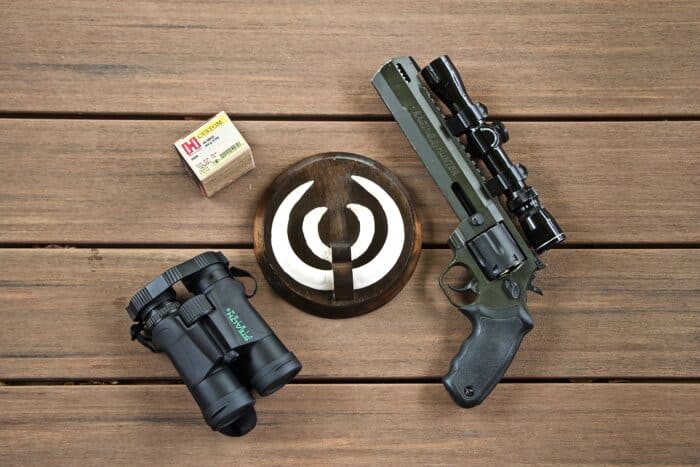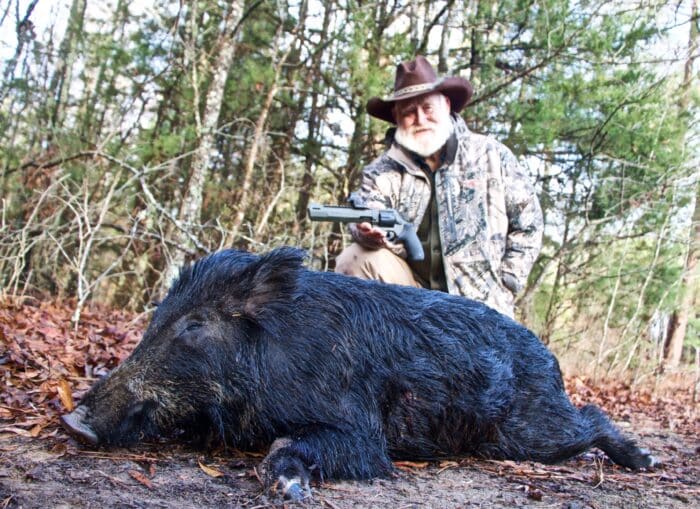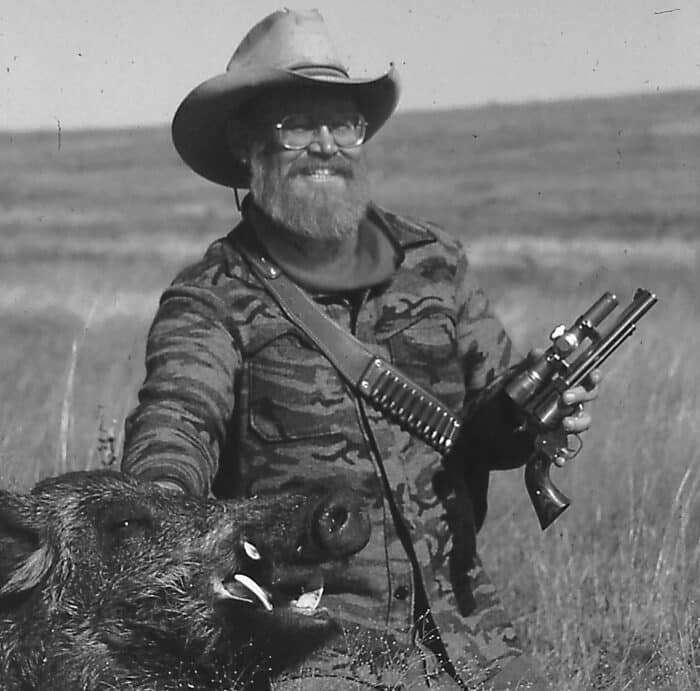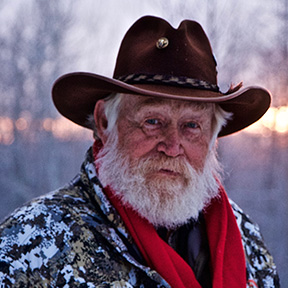Becoming A Hog Pistoleero!
Looking for a bit of a challenge?
Might I suggest hunting wild hogs with a handgun and more specifically doing so with a Taurus Raging Hunter revolver!
Why a pistol and why a revolver over some of the other handgun actions? With me, it goes back to a time when I used to play “Cowboys,” back when Roy Rogers, Gene Autry, Rex Allen, and others rode across the silver screen. I grew up at a time when “cowboys” were king, and the good guys wore white hats, were true to their words, fought the bad guys, and won. It was a time, too, when writers such as Elmer Keith, Al Georg, Hal Swiggett, and a few others wrote about hunting guns with short barrels, and the revolver was the “real pistol.”
I make no apologies for loving revolvers or hunting with them, especially in these days when guns are often “measured” by the total number of bullets one can spit out in a mere heartbeat or by how many hundreds of yards away an animal was taken. Me? I love handguns, specifically “wheel guns,” as opposed to semi-autos, my personal preference.
During my early years, I spent a bit of time “carrying” pistols and, when time permitted, shooting revolvers and single shots. My first revolvers were “borrowed” .22 H&R revolvers, a Colt Peacemaker in .45 Colt (Long Colt), and a .357 Magnum Ruger Blackhawk. With those, I shot many a rabbit (cottontails to eat and jackrabbits to get rid of because they competed with our cattle and the deer for food), pesky armadillos, and the occasional snake. Back then, we didn’t have the wild hog populations we have now. Had we, I would have been hunting hogs with them.
Fast forward several years to when I worked as a wildlife biologist for the Texas Parks & Wildlife Department. By then, I had started to seriously hunt deer with a Ruger Blackhawk in .45 Colt (commonly called the Long Colt, as opposed to the .45 ACP or Automatic Colt Pistol) made famous by the Model 1911 semi-auto. With that particular open-sight revolver, I limited my shot to 50 yards or less. From a hunting rest, at that distance, I could put 5 shots within a 5-inch circle at 50 yards. From a sandbag rest, I could put 5 or 6 shots within less than 3-inches. The rounds I shot back then were hard-cast bullets hand loaded by an old friend, a retired game warden, and deputy sheriff. At the time, most of the .45 Colt ammunition was loaded pretty light because of still being quite a few guns around that had been built only to withstand black powder pressures.
In time, wild hog populations in Texas started expanding and flourishing back in the late 1970s during my days of being the technical assistance biologist (TPWD) for the South Texas region. As such, I helped landowners and hunting groups establish and maintain quality wildlife management programs. On a low-fenced 23,000-acre property, we were trying to increase the deer population from a deer per about 50 acres to about a deer per 30 to 35 acres. In spite of habitat improvements and predator control (removing coyotes just before fawns were born), we were not getting the deer recruitment we desired or expected. The wild hog population, however, was greatly increasing due to bettered range conditions and the establishment of permanent water throughout the property.
I wondered if wild hogs were having an effect on fawn survival. It took some doing, including getting a former Texas Governor involved to get a special license/permit to shoot hogs from a helicopter. In early August, most fawns in that part of Texas were born in mid to late July; using a helicopter as a mobile platform, I “collected” 20 wild hogs that looked like they weighed at least 100 pounds or more. I shot them with a .44 Mag Ruger Super Blackhawk using Hornady’s 240-grain XTP ammo.
I did complete necropsies on each hog, paying particular attention to their stomach content. Interestingly of the 20 wild hogs shot, 18 of them had eaten whitetail fawns within the last several hours! With that information in hand, I was able to convince “the powers that be” that we should, when doing predator control on the ranches I worked with as a wildlife biologist, also be shooting mature hogs. That next summer, before whitetails does were having fawns, we did some serious hog control on selected ranches where we wanted to increase fawn survival rates.
Later that fall, doing our deer surveys, we noted higher fawn survival rates on those properties where we had done hog control after having acquired the then-proper State and Federal permits, using helicopters from which to shoot. Most of the time I did the shooting. Rather than shoot shotguns or semi-auto rifles, I used two revolvers, a Ruger Super Blackhawk Hunter with a 2.5x7x28 long eye relief scope in .44 Mag and a Ruger Super Blackhawk in .44 Mag with open sights. With these two handguns, I shot a considerable number of wild hogs. It was work, but I can assure you, it was great fun as well!
Those “hog shooting sessions” taught me a lot about shooting handguns, particularly when dealing with a moving platform from which to shoot that was not only moving forward at about 30 to 35 miles per hour, but also moving up and down and the targets were moving, ducking and dodging as well.
I could have used a shotgun, but shooting hogs in this manner from a helicopter with revolvers made for great fun, and I became quite proficient in doing so. Back then, we were flying primarily in Bell 47s, helicopters like those used during the Korean War, the kind you see should you watch any of the old M.A.S.H. television shows. I always sat on the right side and shot right-handed, leaning out the open door. Every time I shot a long gun, recoil pushed the backside of my shoulder into the door frame. It hurt. So, one of the other reasons I really liked shooting handguns from a helicopter. With a handgun, it didn’t hurt when I shot.
Toward the tail-end of my helicopter years, I started using a Taurus Raging Bull in .44 Mag, shooting open sight. Being a double action, I did not have to reach up with my thumb to pull back the hammer between shots, and I really like that, plus how accurately it shot.
If you’re interested in hunting wild hogs with a revolver, let me suggest you invest in a double-action Taurus Raging Hunter chambered in .44 Mag or .454 Casull so you can also shoot .45 Colt. The Raging Hunters has an integral scope mount to facilitate mounting a red-dot sight or a long-eye relief scope. The gun’s integral muzzle brake greatly reduces recoil and makes it truly fun to shoot.
One of the things I learned many years ago about shooting and hunting is that most everyone shoots extremely more accurately when shooting from a good, solid rest. I use natural rests such as trees, rocks, and the like whenever they are available, but I also carry a tripod shooting rest. That way, I always have a good rest no matter where I hunt with my revolvers.
When it comes to ammo, handguns are like most other firearms, they can be fickle, and tend to prefer one load or bullet style over others. That said, one of the most forgiving ammo I have ever run through a great number of .44 Mag revolvers is Horandy’s 240-grain XTP Custom. Frankly, I have yet to find a .44 Mag that does not love this particular bullet and load. It is, as Hornady’s tagline states, “Accurate, Deadly and Dependable”!
Now, if you’ll excuse me, I just got a call from Luke Clayton. Luke said he’d found an old, long-tusked boar on some property he just got access to—and it seems to have my name on it!
Professional wildlife biologist/outdoor communicator, Larry Weishuhn, known to many as “Mr. Whitetail”, has established quality wildlife management programs on over 12,000,000 acres throughout North American and other parts of the world. He has hunted big game with rifle and/or handgun on six continents. Larry is a Professional Member of the Boone & Crockett Club, life-member of numerous wildlife conservation organizations including the Dallas Safari Club, Mule Deer Foundation, and Wild Sheep Foundation. He currently serves on the DSC Foundation Board of Directors, is one of three co-founders of the Texas Wildlife Association; is a member of the Legends of the Outdoors Hall of Fame and the Muy Grande Hall of Fame; he too, received the Zeiss Lifetime Achievement Award among many other honors.




